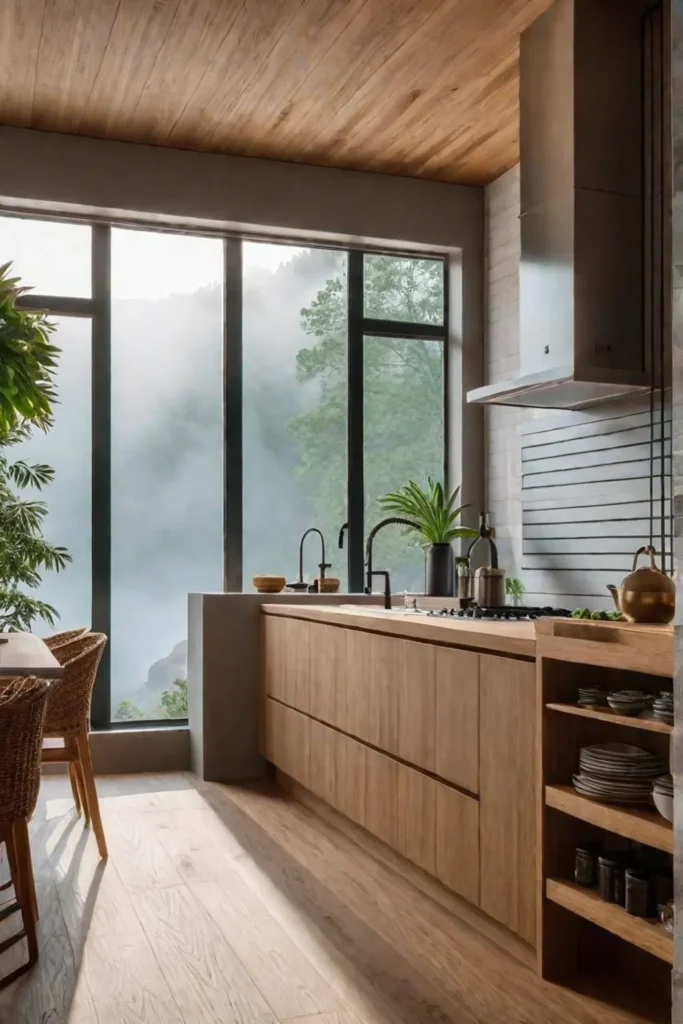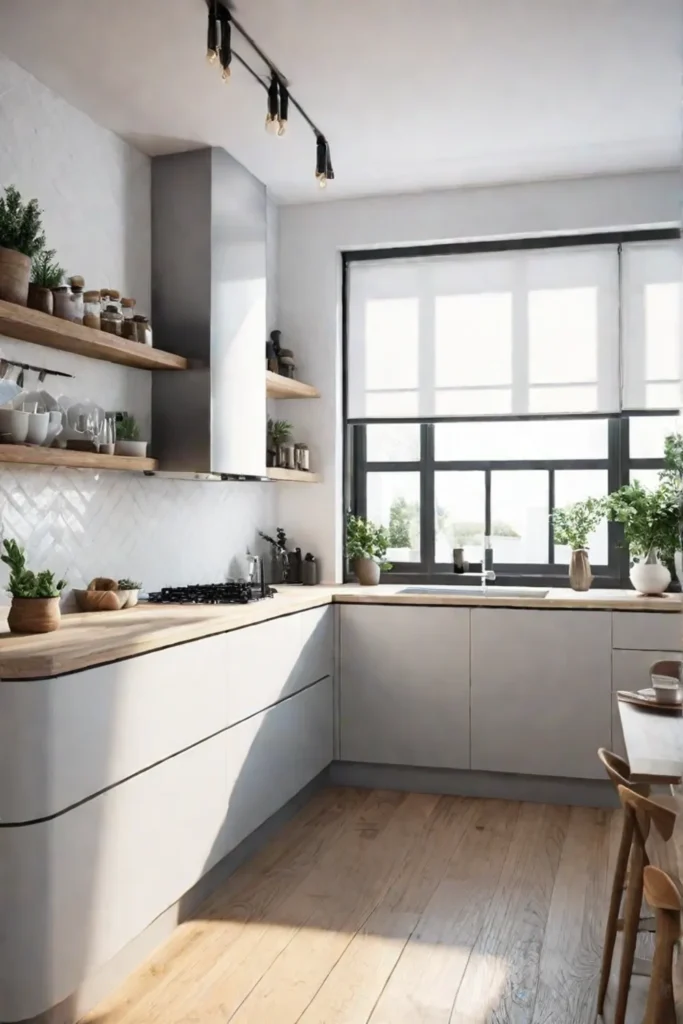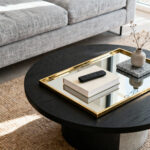Hey there, greetings from New York! Tired of the same old kitchen vibes that scream “generic apartment” louder than a taxi horn at rush hour? Well, buckle up, because we’re about to take a wild ride through five kitchen décor styles that’ll make your culinary space pop like a fresh bagel in a sea of day-olds.
From the zen-like serenity of Japandi to the raw energy of Industrial Chic, we’re diving deep into the design trends that are transforming NYC kitchens faster than you can say “cold brew.” Whether you’re working with a shoebox-sized galley or a sprawling Tribeca loft, I’ve got the insider scoop on how to turn your kitchen into the hottest spot this side of the Hudson. So grab your MetroCard, and let’s embark on a style journey that’ll make your taste buds – and your Instagram followers – sit up and take notice.
Embrace Tranquility: Japandi Kitchen Design
As a New Yorker, I’ve seen countless kitchen trends come and go. But there’s one style that’s caught my eye recently, offering a breath of fresh air in our bustling urban jungle. Enter Japandi – a fusion of Japanese minimalism and Scandinavian functionality that’s taking the design world by storm.

The Art of Blending East and West
Japandi isn’t just another fleeting fad. This design philosophy, which emerged around 2017, marries the best of two worlds: the warm functionality of Scandinavian design and the zen-like minimalism of Japanese aesthetics. The result? A kitchen space that exudes calm, serenity, and understated elegance – something we could all use a little more of in the Big Apple.
Characteristics of Japandi Style
- Clean lines and uncluttered spaces
- Natural materials like wood, bamboo, and stone
- Neutral color palette with occasional pops of muted colors
- Emphasis on craftsmanship and quality over quantity
- Functional yet beautiful design elements
Bringing Japandi to Your NYC Kitchen
- Light Wood Cabinetry: Opt for pale oak or ash cabinets to brighten your space.
- Black Accents: Incorporate matte black hardware or fixtures for contrast.
- Natural Textures: Use linen curtains or bamboo blinds to soften the look.
- Minimalist Hardware: Choose sleek, simple cabinet pulls and knobs.
- Stone Countertops: Go for honed granite or quartz in neutral tones.
The Perfect Balance: Japanese Minimalism Meets Scandinavian Coziness
Japanese minimalism teaches us to appreciate negative space and find beauty in simplicity. It’s about creating a sense of ma – the gap between things. Scandinavian design, on the other hand, brings in the concept of hygge – that cozy feeling of contentment.

In your Japandi kitchen, achieve this balance by:
- Keeping countertops clear of clutter
- Displaying a few carefully chosen items, like a handcrafted ceramic vase
- Using warm, ambient lighting to create a cozy atmosphere
Pro Tip: Sustainable Style
As an advocate for sustainable city living, I can’t stress enough how Japandi aligns with eco-friendly principles. Invest in quality pieces that will last, and choose materials like bamboo or reclaimed wood for a lower environmental impact.
Product Recommendations
- Lighting: Look for paper lantern-inspired pendants or simple dome lights in black or white.
- Cabinet Pulls: Sleek stainless steel bar pulls or minimalist wooden knobs work well.
- Seating: Consider low-back wooden stools or chairs with clean lines.

Embracing Japandi in your kitchen isn’t just about following a trend – it’s about creating a timeless, calming space that serves as a sanctuary in our hectic urban lives. It’s a reminder to slow down, appreciate craftsmanship, and find beauty in simplicity.
As we move from the serene simplicity of Japandi, let’s shift gears and explore a style that embraces the raw energy of city life. Up next, we’ll dive into the world of Industrial Chic kitchens – where edgy meets refined in a perfect urban harmony.
Industrial Chic: Edgy Yet Refined Kitchens
New York City’s converted lofts and repurposed warehouses have long been the inspiration for one of the most captivating kitchen design trends: Industrial Chic. As a native New Yorker, I’ve witnessed firsthand how this style has evolved from its utilitarian roots to become a sought-after aesthetic that marries raw urban edge with sophisticated refinement.
The Essence of Industrial Chic
Industrial chic kitchens are a testament to the city’s ability to reinvent itself. They draw inspiration from the mid-20th century when abandoned factories and warehouses were transformed into living spaces, preserving their original architectural elements. The result? A bold, edgy, and effortlessly cool aesthetic that feels both timeless and contemporary.

Key elements of this style include:
- Exposed brick walls
- Concrete Countertops
- Metal shelving and accents
- Vintage industrial lighting
- Reclaimed wood
- Stainless steel appliances
Crafting Your Industrial Chic Vision
To create an industrial chic kitchen that doesn’t feel like a cold, abandoned warehouse, consider these NYC-inspired tips:
- Balance raw with refined: Pair rough textures like exposed brick with sleek stainless steel appliances.
- Incorporate warmth: Use reclaimed wood for open shelving or a kitchen island to add organic warmth.
- Play with lighting: Install pendant lights with metal shades for task lighting and ambiance.
- Add pops of color: Introduce vibrant artwork or colorful kitchen accessories to break up the neutral palette.
- Mix old and new: Combine vintage industrial furniture with modern pieces for an eclectic touch.
Softening the Edge
While the industrial aesthetic celebrates raw materials, it’s essential to create a space that feels livable. Here’s how to soften the look:
- Use textiles: Add fabric bar stool cushions or a vintage rug to introduce softness.
- Incorporate plants: Bring life to the space with potted herbs or hanging plants.
- Display personal items: Showcase cookbooks, family photos, or artisanal kitchenware to add personality.

DIY Industrial Chic on a Budget
You don’t need a SoHo loft budget to achieve this look. Try these wallet-friendly DIY ideas:
- Paint existing cabinets in a matte charcoal or deep navy for an industrial feel.
- Replace standard light fixtures with affordable industrial-style pendants.
- Create open shelving using pipes and reclaimed wood planks.
- Apply peel-and-stick faux brick wallpaper for an instant industrial backdrop.
The Versatility of Industrial Chic
What I love about industrial chic is its versatility. It can be minimalist and stark, focusing on clean lines and a monochromatic palette. Or it can be eclectic and vibrant, incorporating vintage finds and bold artwork. The key is to make it your own, reflecting your style while honoring the urban roots of the aesthetic.
As we move from the raw appeal of Industrial Chic, let’s take a step back in time to explore another enduring kitchen design trend. The next section delves into Mid-Century Modern: Timeless Appeal in the Kitchen, where we’ll discover how this iconic style continues to influence contemporary urban spaces with its clean lines and functional beauty.
Mid-Century Modern: Timeless Appeal in the Kitchen
There’s one style that’s stood the test of time, much like the iconic skyline of our beloved city – Mid-Century Modern. This design movement, born in the mid-1900s, continues to captivate urban dwellers and design enthusiasts alike with its clean lines, organic shapes, and unparalleled functionality.

The Essence of Mid-Century Modern Design
Mid-Century Modern isn’t just a style; it’s a philosophy. It’s about creating spaces that are as practical as they are beautiful, much like the efficient yet stunning design of the New York subway system. In the kitchen, this translates to:
- Open layouts that maximize space and light
- A seamless blend of indoor and outdoor elements
- Furniture and fixtures that prioritize form and function equally
Bringing Mid-Century Magic to Your Kitchen
Want to infuse your kitchen with some Mad Men-esque charm? Here’s how:
- Invest in iconic pieces: An Eames chair or a Saarinen table can instantly elevate your space.
- Embrace bold colors and geometric patterns: Think vibrant oranges, deep greens, and abstract designs.
- Go sleek with appliances: Opt for minimalist hardware and streamlined appliances that blend seamlessly with your cabinetry.
Mid-Century Meets Modern Day
You might be wondering, “Jacob, how can I make this retro style work in my contemporary New York apartment?” It’s all about balance, folks. Mix vintage finds from Brooklyn flea markets with modern pieces. A classic Knoll credenza paired with state-of-the-art smart appliances creates a perfect harmony of old and new.

The Masters Behind the Movement
No discussion of Mid-Century Modern is complete without tipping our hats to the design giants who shaped it. Charles and Ray Eames, Eero Saarinen, and George Nelson are just a few names that should be on your radar. Their innovative designs continue to inspire and influence today’s urban spaces.
Where to Source Your Mid-Century Treasures
For my fellow New Yorkers looking to dive into this style, here are some go-to spots:
- Design Within Reach for new, licensed reproductions
- 1stDibs for authentic vintage pieces
- Local vintage shops in Brooklyn and Queens for unique finds
Remember, Mid-Century Modern is more than just a look – it’s about creating a space that’s both beautiful and functional. It’s perfect for our fast-paced city life, where every square foot counts, and style is never sacrificed for practicality.
As we move from the sleek lines and timeless appeal of Mid-Century Modern, let’s shift gears to a style that’s all about personal expression and vibrant energy. Get ready to unleash your inner free spirit as we dive into Bohemian Rhapsody: Eclectic and Vibrant Kitchens.
Bohemian Rhapsody: Eclectic and Vibrant Kitchens
Nothing breathes life into a home quite like a Bohemian-inspired culinary space. It’s time to break free from the mundane and embrace the vibrant, eclectic charm of Boho chic.

The Essence of Bohemian Style
Bohemian style is the rebellious child of interior design, refusing to conform to rigid rules. It’s a melting pot of colors, patterns, and textures that somehow harmonize in beautiful chaos. Rooted in 19th-century Parisian counterculture, this style has evolved into a global phenomenon, drawing inspiration from Moroccan bazaars, Indian spice markets, and Mexican casitas.
The beauty of Boho lies in its ability to tell your story. Each object, from that hand-painted tagine you picked up in Marrakech to the vintage macramé plant hanger, becomes a chapter in your narrative.
Designing a Bohemian-Inspired Kitchen
- Color is Your Best Friend
- Ditch the monochrome and embrace a palette that pops
- Think jewel tones: emerald greens, sapphire blues, and ruby reds
- Don’t shy away from mixing patterns – stripes, florals, and geometrics can coexist beautifully
- Texture, Texture, Texture
- Layer rugs for a cozy underfoot feel
- Incorporate woven baskets, ceramic pots, and wooden cutting boards
- Hang textiles like embroidered tapestries or colorful dish towels
- Bring the Outdoors In
- Plants are non-negotiable in a Boho Kitchen
- Try hanging herb gardens or a collection of succulents on open shelving
- Use natural materials like bamboo, rattan, and jute
- Open Shelving is Your Canvas
- Display your most cherished pieces – mismatched china, colorful glassware, and global finds
- Mix functional items with decorative pieces for a curated look
- Lighting as Art
- Opt for statement pendant lights or a collection of mismatched fixtures
- Moroccan-inspired lanterns can add an exotic touch

Creating Cohesion in Chaos
The key to nailing the Bohemian look without veering into cluttered territory is to establish a common thread. This could be a recurring color, a consistent material (like wood or brass), or a theme (such as travel or nature).
For smaller NYC kitchens, focus on one statement wall or area to prevent overwhelming the space. Use vertical space wisely with hanging planters and wall-mounted shelves.
Bohemian Sub-Styles to Explore
- Moroccan Boho: Rich jewel tones, intricate tiles, and metallic accents
- Southwestern Boho: Earthy colors, Navajo patterns, and cacti galore
- Coastal Boho: Lighter palette with pops of blue, driftwood accents, and seashell collections
Remember, the heart of the Bohemian style is personal expression. It’s about creating a space that feels lived-in, loved, and uniquely you. So go ahead, mix that antique French coffee press with your grandmother’s china and that quirky mug from your favorite NYC coffee shop. In a Boho kitchen, it all works.
As we drift away from the vibrant, eclectic world of Bohemian kitchens, let’s shift our gaze northward to a style that’s the antithesis of Boho’s organized chaos. Get ready to declutter your mind and your space as we explore the serene simplicity of Scandinavian kitchens in our next section, “Scandinavian Simplicity: Bright and Airy Kitchens.”
Scandinavian Simplicity: Bright and Airy Kitchens
In New York, you see your fair share of cramped, cluttered kitchens. But there’s a design philosophy that’s been catching my eye lately, one that feels like a breath of fresh air in our concrete jungle. I’m talking about Scandinavian simplicity, folks. It’s not just about IKEA furniture anymore; it’s a way of life that’s transforming kitchens across the city.

The Heart of Scandinavian Design
At its core, Scandinavian design is all about creating spaces that work for you, not against you. It’s like the subway system of interior design – efficient, functional, and (when done right) beautifully simple. This style emerged in the early 20th century, focusing on human needs and well-being. A Scandinavian kitchen can be your oasis in a city where stress seems to seep through the walls.
The key principles? Think light, airy, and uncluttered. It’s about stripping away the unnecessary and celebrating the essentials. In true New York fashion, it’s making the most of what you’ve got – but with a lot more style.
Bringing Nordic Vibes to the Big Apple
So, how do you bring a touch of Stockholm to your NYC kitchen? Here are some tips that even the most space-challenged apartment can embrace:
- Embrace the light: Maximize natural light with sheer window treatments. If you’re blessed with big windows, let that sunshine in!
- Go for a light palette: Think whites, light woods, and soft grays. It’s like giving your kitchen a blank canvas.
- Add pops of color: Don’t be afraid to throw in some vibrant accents. A bright blue kettle or colorful dish towels can add life without overwhelming the space.
- Please keep it simple: Opt for sleek, minimal cabinetry. Hardware? Who needs it? Push-to-open mechanisms are your new best friend.
- Bring in nature: Add some greenery with potted herbs or a small plant. It’s like having a tiny Central Park right in your kitchen.

Debunking Scandinavian Myths
Now, I know what you’re thinking. “Jacob, isn’t Scandinavian design just a fancy way of saying ‘plain and boring’?” Not at all, my friends. This style is all about creating a serene, welcoming environment. It’s not about being stark or cold; it’s about finding beauty in simplicity.
Another misconception? That it’s all about white. While white is certainly a staple, Scandinavian design isn’t afraid of color. It’s just more strategic about how and where it’s used. Think of it as the color equivalent of a New York capsule wardrobe – versatile, thoughtful, and always chic.
Making It Work in Any Space
Whether you’re dealing with a spacious loft in Tribeca or a cozy studio in the East Village, Scandinavian design can work for you. In smaller kitchens, focus on maximizing vertical space with open shelving. For larger areas, consider a kitchen island that doubles as a dining space – perfect for those impromptu brunches with friends.
Remember, the goal is to create a space that feels open and inviting. It’s about crafting a kitchen that makes you want to linger over your morning coffee, not rush out the door to the nearest diner.
As we wrap up our tour of Scandinavian simplicity, it’s clear that this style offers more than just good looks. It’s a way to bring a sense of calm and order to our chaotic city lives. But of course, design is all about personal expression. As we move towards our conclusion, let’s reflect on how these different styles – from farmhouse chic to Scandinavian simplicity – can be mixed and matched to create a kitchen that’s uniquely yours. After all, in a city of millions, your home should be one in a million.

Conclusion
Alright, urban dwellers, we’ve just taken a whirlwind tour through five kitchen styles that are hotter than a New York minute. From the serene simplicity of Japandi to the eclectic vibrancy of Bohemian, and the timeless appeal of Mid-Century Modern, we’ve covered more ground than a seasoned cabbie during rush hour. But here’s the kicker – there’s no one-size-fits-all solution in the Big Apple.
Your kitchen should be as unique as your favorite slice joint or that hidden speakeasy you swear you’ll never reveal. So go ahead, and mix and match these styles like you’re crafting the perfect playlist for your morning commute. Maybe you’ll pair the clean lines of Scandinavian design with a pop of Bohemian color, or blend Industrial Chic with Mid-Century Modern for a look that’s pure NYC. Remember, in a city that never sleeps, your kitchen should be wide awake and ready to impress. Now get out there and start cooking up some style – your taste buds (and your guests) will thank you.










